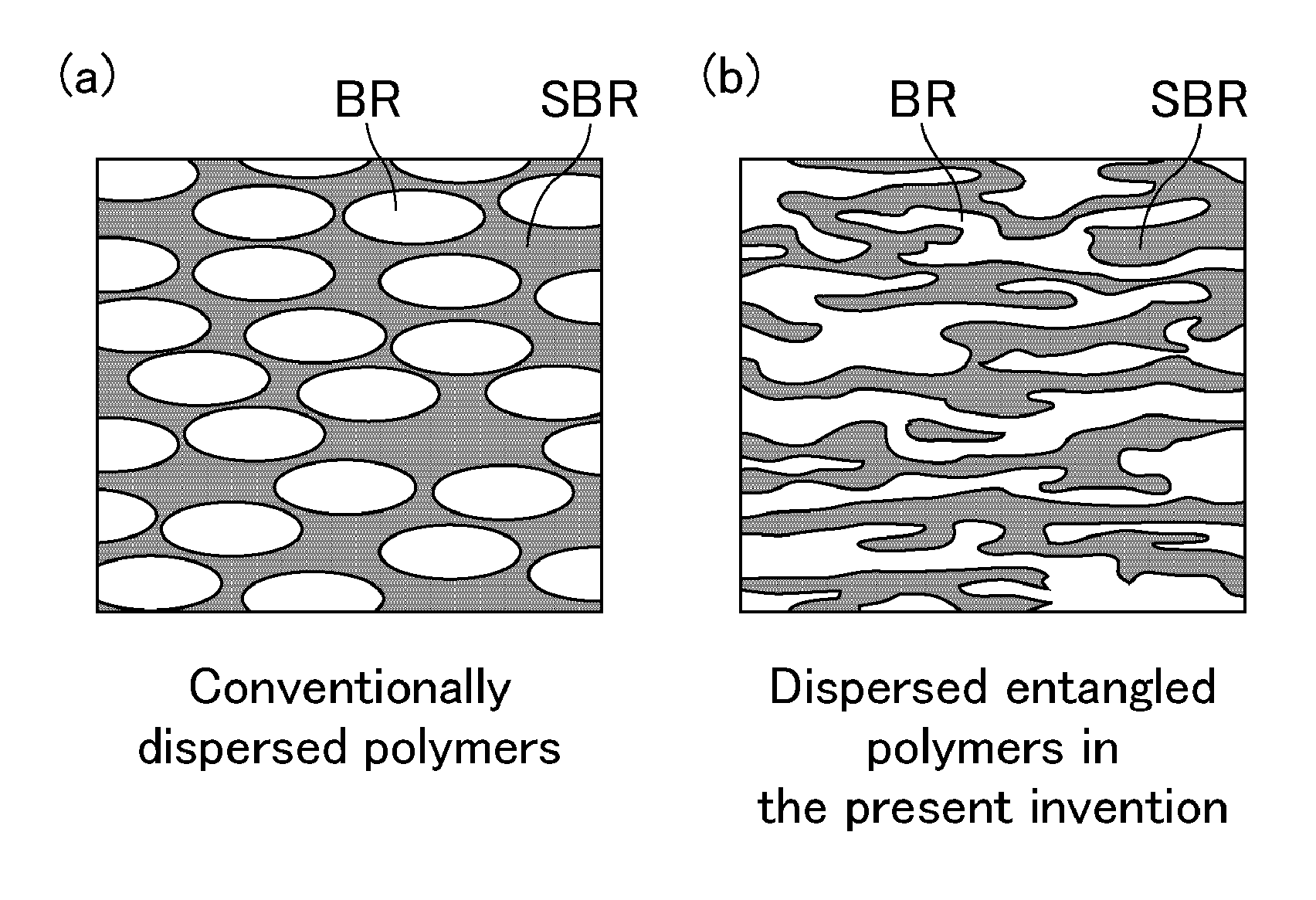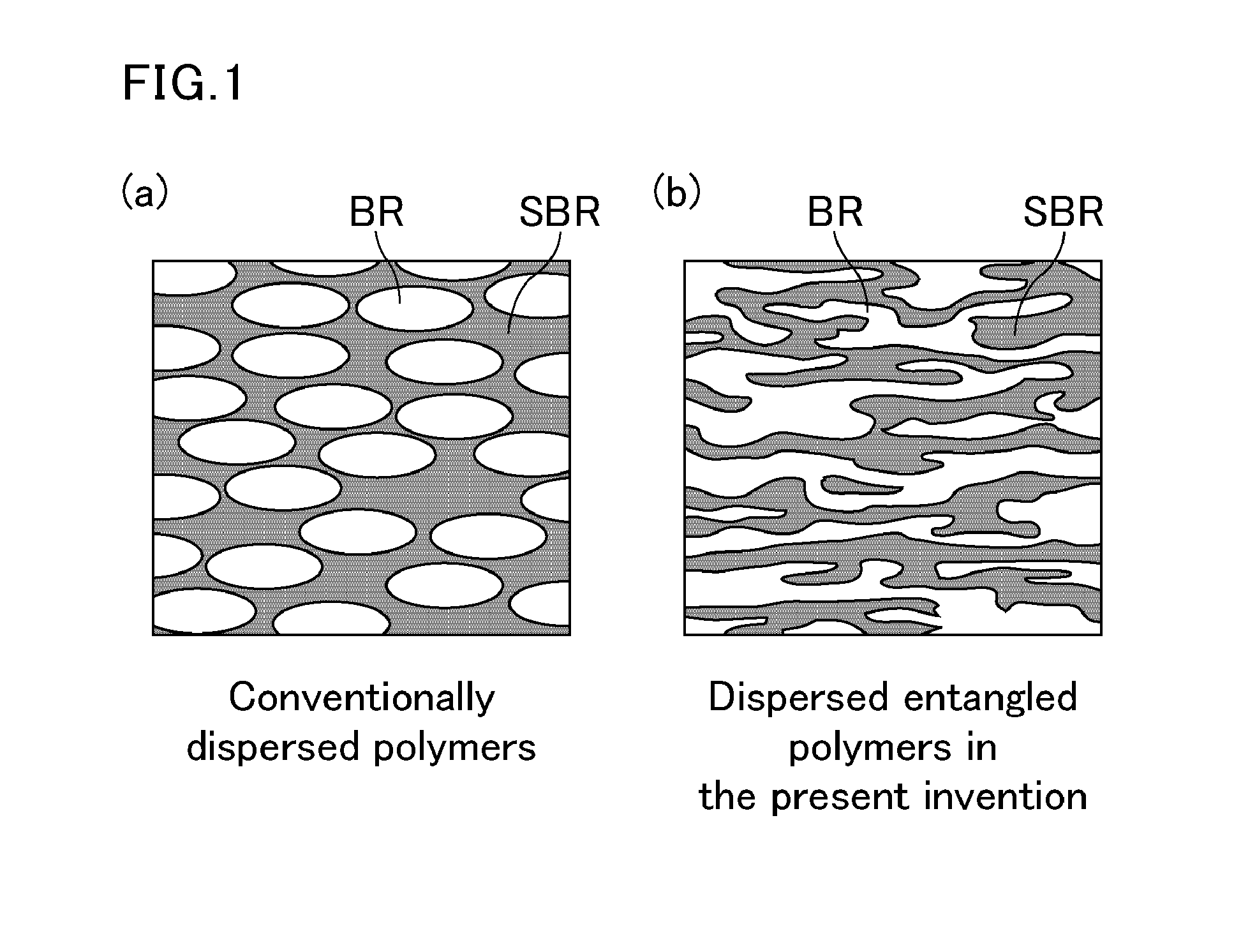Pneumatic tire
a technology of pneumatic tires and coupling agents, which is applied in the field of pneumatic tires, can solve the problems of increasing the cost of silane coupling agents, poor wet grip performance of silicon black formulations, and poor abrasion resistance of carbon black formulations, so as to achieve excellent durability, balanced improvement of fuel economy, and good wet grip performan
- Summary
- Abstract
- Description
- Claims
- Application Information
AI Technical Summary
Benefits of technology
Problems solved by technology
Method used
Image
Examples
production example 1
Oil-Extended E-SBR
[0082]An amount of 1,200 g of water, 27 g of the emulsifier (1), 0.9 g of the emulsifier (2), 4.8 g of the electrolyte, 312 g of styrene, 288 g of butadiene, and 0.15 g of the molecular weight regulator were charged into a pressure-proof reactor equipped with a stirrer. The temperature of the reactor was adjusted to 5° C., followed by addition of an aqueous solution containing 0.6 g of the radical initiator and 0.92 g of SFS and an aqueous solution containing 0.42 g of EDTA and 0.3 g of the catalyst to the reactor to cause polymerization. Five hours after the start of polymerization, 1.2 g of the polymerization terminator was added to stop the reaction, thereby obtaining a latex. To the latex was added 225 g of TDAE, and the mixture was left for a period of half a day so that the latex absorbed the oil. The resulting latex was added to an alcohol and the mixture was adjusted to a pH of 3 to 5 using a saturated sodium chloride aqueous solution or formic acid so that...
production example 2
Oil-Extended S-SBR
[0084]An amount of 18 L of n-hexane, 800 g of styrene (Kanto Chemical Co., Inc.), 1,200 g of butadiene, and 1.1 mmol of tetramethylethylenediamine were charged into a 30-L pressure-proof vessel sufficiently purged with nitrogen, followed by heating to 40° C. Next, 1.8 mL of 1.6 M butyllithium (Kanto Chemical Co., Inc.) was added and then the temperature was raised to 50° C., followed by stirring for 3 hours. Then, 4.1 mL of the terminal modifier was added and the resulting mixture was stirred for 30 minutes. To the reaction solution were added 15 mL of methanol and 0.1 g of 2,6-tert-butyl-p-cresol, and then 1,200 g of TDAE was added, followed by stirring for 10 minutes. Thereafter, agglomerates were collected from the polymer solution by steam stripping. The agglomerates were dried under reduced pressure for 24 hours to obtain a modified SBR (SBR5). The modified SBR had a bound styrene content of 41% by mass, a Mw of 1,196,000, and a vinyl content of 40 mol %.
production example 3
Non-Oil-Extended S-SBR
[0085]An amount of 18 L of n-hexane, 540 g of styrene (Kanto Chemical Co., Inc.), 1,460 g of butadiene, and 17 mmol of tetramethylethylenediamine were charged into a 30-L pressure-proof vessel sufficiently purged with nitrogen, followed by heating to 40° C. Next, 10.5 mL of butyllithium was added and then the temperature was raised to 50° C., followed by stirring for 3 hours. Then, 3.5 mL of a 0.4 mol / L solution of silicon tetrachloride in hexane was added and stirred for 30 minutes. Then, 30 mL of the terminal modifier was added and stirred for 30 minutes. To the reaction solution was added 2 mL of a solution of 0.2 g of 2,6-tert-butyl-p-cresol (Ouchi Shinko Chemical Industrial Co., Ltd.) in methanol (Kanto Chemical Co., Inc.). The resulting reaction solution was put into a stainless steel container containing 18 L of methanol and then agglomerates were collected. The agglomerates were dried under reduced pressure for 24 hours to obtain a modified SBR (SBR6). ...
PUM
| Property | Measurement | Unit |
|---|---|---|
| softening point | aaaaa | aaaaa |
| atomic numbers | aaaaa | aaaaa |
| nitrogen adsorption specific surface area | aaaaa | aaaaa |
Abstract
Description
Claims
Application Information
 Login to View More
Login to View More - R&D
- Intellectual Property
- Life Sciences
- Materials
- Tech Scout
- Unparalleled Data Quality
- Higher Quality Content
- 60% Fewer Hallucinations
Browse by: Latest US Patents, China's latest patents, Technical Efficacy Thesaurus, Application Domain, Technology Topic, Popular Technical Reports.
© 2025 PatSnap. All rights reserved.Legal|Privacy policy|Modern Slavery Act Transparency Statement|Sitemap|About US| Contact US: help@patsnap.com


